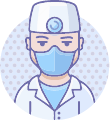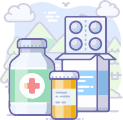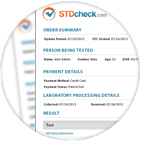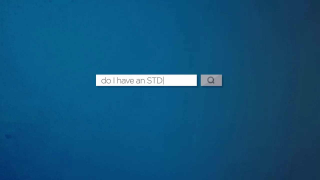Chlamydia Test
Chlamydia Testing Process
More Information About Our Chlamydia Urine Test
Do you use blood or urine to test for chlamydia?
Our chlamydia test requires the lab to collect a urine sample. No blood is required for a chlamydia test. Pricking, swabbing, and undressing will never be required for an NAA chlamydia test.How do I prepare for a chlamydia urine Test?
You must avoid urinating for at least one hour before your chlamydia test. The sample must consist of first-catch urine. First-catch urine is about 20-30mL of the initial urine stream. The sample should not consist of anything more than first-catch urine, as this may dilute the sample. Female test takers are encouraged to avoid cleansing the labial area before providing a sample. No fasting is required. No other preparation is necessary.When should I test for chlamydia?
If you’ve recently had an experience that you believe may have put you at risk of chlamydia, our doctors recommend waiting at least 1-5 days post-exposure to be tested. At the very minimum, you should wait 24 hours after you may have been exposed to chlamydia. For the most accurate possible results, you should get tested two weeks after potential exposure. If you have undergone chlamydia treatment, you should be tested again 21 to 28 days after treatment has ended to verify that the bacterium has been eliminated. If you have tested positive for gonorrhea, you should be tested for chlamydia. These infections often coincide, and the symptoms are very similar.How do I read my chlamydia test results?
If your chlamydia test results come back as positive, then the bacterium Chlamydia trachomatis was found in your system, and you do have chlamydia. If your results are negative, then you do not have chlamydia. If you test too soon after exposure, your results may not be entirely accurate. Try and wait up to 2 weeks post-potential exposure, to ensure the most accurate possible results.Is there a chlamydia cure?
Chlamydia is entirely curable by treatment through antibiotics. If you test positive, you are eligible for an over-the-phone consultation with one of our doctors, who will be able to talk with you about treatment options. If need be, antibiotics can be prescribed and picked up at your local pharmacy.Who should be tested for chlamydia?
Both women and men are susceptible to chlamydia. The CDC states that there are almost 3 million new chlamydia infections each year in the U.S. Chlamydia is extremely common because it often shows no symptoms at all and is spread very easily. According to a CDC report, “chlamydia prevalence among sexually active persons aged 14-24 years is nearly three times the prevalence among those aged 25-39 years.” The CDC strongly recommends testing for chlamydia in all sexually active women at the age of 25 or younger. Chlamydia is considered more prevalent among young women, as the cervix is still in the developmental stages, and is more susceptible to bacteria. Regardless of age, if you have recently had unprotected sex with a partner whose STD status you are unaware of, you should be tested for chlamydia.
When is the Right Time to Test For Chlamydia?
You should always know your sexual status. The best time to test for chlamydia is now.
If you feel that you have recently come into contact with chlamydia, you should wait a few days to be tested. It's best to wait at least 1-5 days after potential chlamydia exposure, but two weeks is ideal.
You should be tested for chlamydia again at 21 to 28 days after you have completed treatment, to ensure that the the bacterium is no longer found in your system.
If you have tested positive for gonorrhea, you should be tested for chlamydia as soon as possible; since chlamydia and gonorrhea are widely known as co-existing infections.
Having just one of these infections puts you at risk, or causes you to be more susceptible to contracting the other. We recommend testing for chlamydia and gonorrhea at the same time, which is why we offer the chlamydia/gonorrhea test panel.
If you are not aware of your sexual status regarding other STDs, including Gonorrhea, Syphilis, HIV-1, HIV-2, Hepatitis A, Hepatitis B, Hepatitis C, HSV 1 and HSV 2, Mycoplasma Genitalium, or Trichomoniasis, then our doctors strongly recommend the 13 Test Panel, which tests for the most common STDs.
For any questions regarding which test you should take, or when you should be tested, reach out to a Care Advisor at 1-800-456-2323.
Medically Reviewed by Joshua Hwang, MD on February 8, 2023
STD testing is easy with our 13 Test Panel
Our Service Includes:

Same labs trusted by physicians and hospitals in your area

Sent to your email as soon as they are available

If your test result is positive, you can speak with one of our doctors

Our trained Care Advisors are available over the phone or online to answer your questions

With our 4500 testing centers nationwide, your sample collection is easy and convenient

If you need treatment, our doctors can prescribe medication, at their discretion, for pick-up at your local pharmacy
What happens if you test positive for Chlamydia?
If you test positive for Chlamydia, you are eligible for a phone consultation with one of our doctors. You can choose a convenient time for this phone consultation. Our doctor will explain what your results mean, ask you questions and prescribe treatment or request further testing at their discretion.
We are here for you. Call us at 1-800-456-2323









